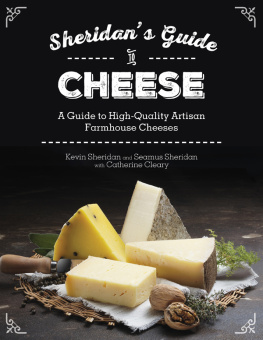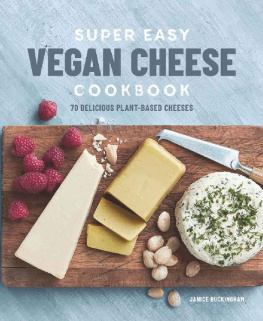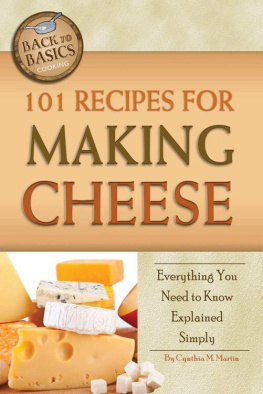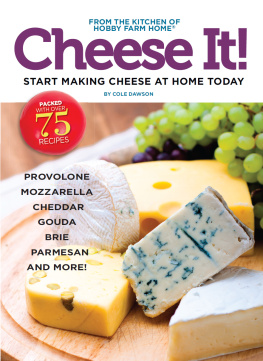The Guide to
West Coast Cheese

The Guide to
West Coast Cheese
MORE THAN 300 CHEESES
HANDCRAFTED IN
CALIFORNIA, OREGON,
AND WASHINGTON
Sasha Davies

To my husband, Michael,
without whom my life in cheese
and so many other wonderful things
would not be possible.
Copyright 2010 by Sasha Davies. All rights reserved.
Photographs by the author. Illustrations by Rory Phillips.
Design by Jane jeszeck/Jigsaw, www.jigsawseattle.com
Maps by Jason Clark of Clark Cartography.
Cheese labels are used with permission from each company.
Frontispiece: A stack of Rinconada Dairy cheeses on display at
Raymond & Co. Cheesemongers in Glen Ellen, California
Published in 2010 by Timber Press, Inc.
The Haseltine Building
133 S.W. Second Avenue, Suite 450
Portland, Oregon 97204-3527
www.timberpress.com
2 The Quadrant
135 Salusbury Road
London NW6 6RJ
www.timberpress.co.uk
ISBN-13: 978-1-60469-090-3
Printed in China
Library of Congress Cataloging-in-Publication Data
Davies, Sasha.
The guide to West Coast cheese : more than 300 cheeses
handcrafted in California, Oregon, and Washington / Sasha Davies.
p. cm.
Includes bibliographical references and index.
ISBN 978-1-60469-090-3
1. CheesePacific Coast (U.S.)Guidebooks. 2. CheeseVarieties
Pacific Coast (U.S.)Guidebooks. 3. CheesemakersPacific Coast (U.S.)Guidebooks. I. Title.
SF274.U6D393 2010
641.3730979dc22
2009053733
Contents
.
Washington Cheesemakers

Oregon

California Cheesemakers

California Cheesemakers
Acknowledgments

I would like to thank all the people who have offered their generous help and support to make this book a reality.
First and foremost, I extend my deepest gratitude to the cheesemakers of California, Oregon, and Washington not only for the wonderful cheeses they produce but also for the time they dedicated to assist me with this book.
A special thanks to Alyce Birchenough, Allison Hooper, and Paula Lambert; women who have made incredible contributions to the greater world of American cheese, encouraged all of my endeavors in the industry, and provided endless technical information on cheese and cheesemaking.
Tami Parr, Kim Iannotti, Steve Jones, and Lynne Devereaux are cheese colleagues that I am lucky enough to call my friends. They have provided logistical support, cheese samples, and encouragement throughout the creation of this guide.
With immense gratitude for time they spent reviewing pieces of the manuscript and their constructive criticisms, Id like to thank Bryan Davies, Rose Gabaeff, and Jonathan Tepperman.
Last but not least, a heartfelt thank you to my editor, Mollie Firestone, for her meticulous work on this book from start to finish, and to the folks at Timber Press for rallying behind the West Coast Cheese movement.
Preface

The very first cheesemaker I visited after I began working in the industry was Californias Cowgirl Creamery. My father and I drove out to Point Reyes Station to watch cheesemaker Maureen Cunnie make Red Hawka washed rind gem perfectly suited to the damp, coastal climate. Through the viewing window we could see Maureen and her team scoop small, silken cubes of curds into the drum-shaped forms. Whey rushed down the gently sloped table, draining off one corner into a tall bucket. Rolling racks of Red Hawk and Mt. Tam, stacked almost as high as the ceiling, were shuffled around to make room for incoming cheese. I was intoxicated by the aromas, the process, and even the tidy uniforms, stark white all the way down to the squeaky rubber boots. There was no turning back.
It took a couple of years for my attention to stretch beyond the cheeses themselves: all I wanted to do was look at them, taste them, and learn how they were made. When my palate was somewhat sated, I started to think more about the origin of each cheese, specifically the land and people behind it. Embarking on an adventurous project called Cheese by Hand, my husband and I began a four-month road trip around the United States with scheduled visits to forty small-scale cheesemakers. I met with West Coast leaders in the American cheese movement who have created some of the most iconic of U.S. cheeses, such as Humboldt Fog from Cypress Grove Chevre and Rogue River Blue from Rogue Creamery. I learned that they do so much more than just making wonderful cheeses. Each has been a fixture within their community for decades, providing jobs and fostering growth and stability for regional dairy farms. Something clicked for me at this point and I understood that cheese is more than a delectable food: its a vehicle for community and for understanding our relationship to the land.
Even with this more pragmatic perspective, I am still moved by the romantic side of cheese and the rustic treasures that can be found by rumbling down dusty, unpaved roads and following hand-painted signs. Walking through the door of the Matos Cheese Factory in northern California is like stepping back in time. On the simple countertop sits an old cash register and a mesh-covered cut wheel of St. George, the only cheese they make. The stark white walls are adorned with a cross and a couple of tea towels displaying maps of the Azores, the homeland of the Matos family. The open door behind the counter offers a peek at ceiling-height shelves filled with golden rounds, each one marked with a date in red pen.
When I was first learning about cheese, two of my favorite books were reference-style guides that profiled individual cheeses from specific regions. These were invaluable in helping me to understand what to expect from each cheese and arming me with useful details such as seasonality and pairing suggestions. After relocating from New York to Oregon, I searched for ways to discover the intimate details of the astounding bounty of cheese in the western states. Those guides, coupled with my burning desire to know more about West Coast cheeses, were the inspiration for this project.
This book is written for cheese-curious consumers at any level: beginning, expert, and everything in between. The first several chapters contain primers on dairy animals, cheesemaking, and enjoying cheese at home; these represent the highlights of what Ive learned in classes, with cheesemakers, from books, and alongside the many experts Ive worked for in the industry. What follows is the Cheese Atlas, which details more than 300 cheeses that are made in California, Oregon, and Washington. Woven throughout the cheese entries are more in-depth explorations of some commonly produced cheeses, as well as profiles of specific producers who are not only making beautiful cheese but are also taking an innovative approach to their work. In the back of the book you will find resources to help further your cheese experience: a glossary of helpful terms, a list of the cheesemakers included in this guide, and a selection of U.S. shops that stock West Coast cheese.
Next page













